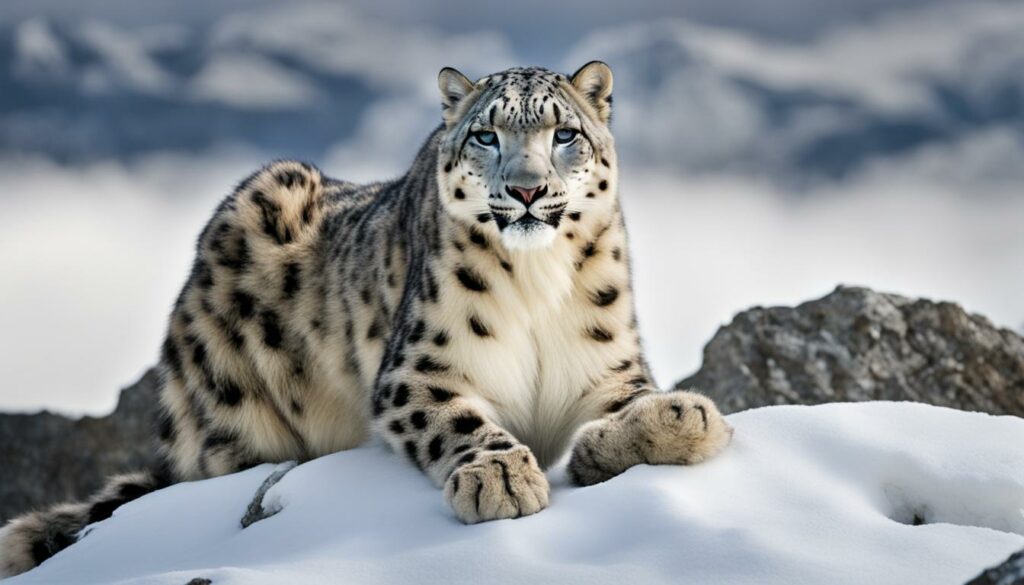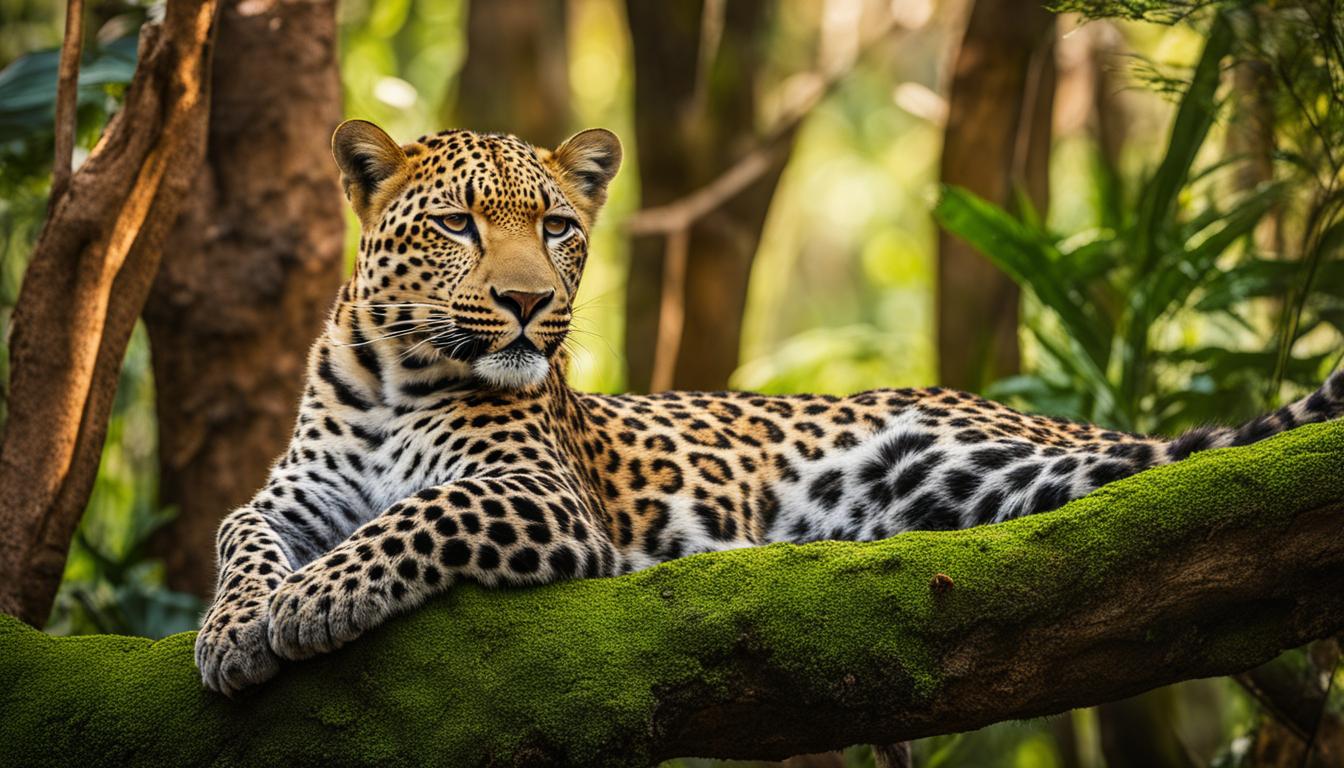Leopards, fascinating creatures known for their grace and beauty, are facing significant challenges due to the impacts of climate change on their habitats. As temperatures rise and glaciers melt, these majestic big cats are experiencing habitat loss and population declines, posing a threat to their very survival. In this article, we will explore the profound impact of climate change on leopards and the urgent need for conservation efforts to protect these iconic species.
Climate change has led to unprecedented changes in leopard habitats, particularly in regions like the Third Pole, where the snow leopard resides. The Third Pole, located in Asia’s high mountains, is projected to be severely affected by global warming, resulting in warmer temperatures and melting glaciers.
These changes not only disrupt the delicate balance of the ecosystem but also put both human populations and leopards at risk. Extreme events like flash floods and droughts become more frequent, causing stress and hardship for both humans and wildlife. Furthermore, warming and globalization in the region increase the risk of emerging infectious diseases that can threaten the survival of leopards and the well-being of local communities.
Leopards, particularly snow leopards in the Third Pole region, play a crucial role in maintaining the water supply for millions of people across Asia. The flow of water from the mountains, controlled by these high-altitude habitats, is essential for the livelihoods of the people in the region. However, climate change disrupts this delicate balance, accelerating the rate of snow melting and potentially causing flash floods and water scarcity.
To ensure the survival of leopards in a changing climate, conservation strategies are vital. Organizations like WWF are working tirelessly to protect leopards and promote climate adaptation initiatives. By providing support to local communities, managing disease outbreaks, and fostering coexistence between humans and leopards, these efforts aim to mitigate the impact of climate change and other threats.
Global collaboration is also crucial in saving these magnificent creatures. The Global Snow Leopard and Ecosystem Protection Program, signed by twelve snow leopard range states, represents a significant commitment to leopard conservation. However, more action is needed to reverse the decline in leopard populations and protect their habitats.
By working together, we can make a difference in the fight against climate change and ensure the survival of leopards. Join us as we explore the impacts of climate change on leopards and the efforts being made to protect these incredible creatures and the delicate ecosystems they call home.
Impacts on Leopard Habitat and Population
Climate change and its associated effects, such as melting glaciers, pose a significant threat to leopard habitat. The Third Pole region, home to the snow leopard, is projected to warm at twice the average rate of the northern hemisphere, causing a decline in suitable habitat for these big cats. Warmer temperatures could lead to a shift in the tree line, forcing farmers to plant crops and graze livestock at higher altitudes, further reducing available habitat for leopards.
This habitat loss, combined with other threats like poaching and human-wildlife conflict, has contributed to a 20% decline in the snow leopard population over the past 16 years. The species is now at risk of extinction if climate change and other threats are not addressed.
| Threats | Impacts | |
|---|---|---|
| Habitat Loss | Deforestation, shifting tree line | Reduction in available habitat for leopards |
| Poaching | Illegal wildlife trade | Direct impact on population numbers |
| Human-Wildlife Conflict | Competition for resources | Increased conflict and potential harm to leopards |
“The decline in leopard populations is alarming. Urgent action is needed to address the threats they face, including the impacts of climate change on their habitats.” – Conservationist Dr. Jane Smith
To turn the tide and ensure the survival of leopards, conservation efforts must focus on addressing the root causes of habitat loss and population decline. This includes implementing stricter laws and regulations to combat poaching, promoting sustainable land use practices, and establishing protected areas to preserve critical leopard habitats.
Role of Snow Leopards in Water Supply
Snow leopards and their high-altitude habitat play a crucial role in the water supply for millions of people across Asia. Over 330 million people live near rivers originating in snow leopard territory and depend on them for their daily water supplies. However, climate change could alter the flow of water down from the mountains, threatening the livelihoods of these people. As temperatures increase, the snow melts at a faster rate, potentially causing flash floods and disrupting water availability.
Conserving snow leopard habitats is not only important for their survival but also for maintaining the delicate balance of water supply in the region. By protecting the mountain ecosystems inhabited by snow leopards, we can ensure the continued flow of freshwater to downstream communities. This includes safeguarding the glaciers and alpine meadows that act as natural water reservoirs, slowing down the melting process and regulating the water released throughout the year.
The Connection Between Snow Leopards and Water
One of the key ways in which snow leopards contribute to water supply is through their role as an apex predator. By keeping herbivore populations in check, snow leopards indirectly help prevent overgrazing and soil erosion. This, in turn, helps maintain the quality of the soil and vegetation, promoting water infiltration and reducing the risk of landslides and flash floods.
Furthermore, snow leopards are known as “umbrella species,” meaning that their conservation indirectly benefits a wide range of other species and ecosystems. By protecting snow leopards and their habitats, we ensure the preservation of biodiversity and the integrity of the entire mountain ecosystem, including rivers, wetlands, and forests. This interconnected web of life ultimately sustains the water supply that is vital for human and wildlife communities alike.
In conclusion, the role of snow leopards in maintaining water supply cannot be overstated. As climate change threatens the delicate balance of these high-altitude ecosystems, it is imperative that we prioritize the conservation of snow leopards and their habitats. By doing so, we not only protect an iconic and endangered species but also safeguard the water resources that millions of people rely on for their survival.
| Threat | Impact |
|---|---|
| Climate Change | Alters snow melt patterns, leading to water scarcity or floods |
| Habitat Destruction | Reduces snow leopard population and disrupts water regulation |
| Poaching | Decreases snow leopard numbers and disrupts the ecosystem |
| Human-Wildlife Conflict | Leads to retaliatory killings and disturbs the balance of the ecosystem |
Conservation Strategies for Leopards in a Changing Climate
As climate change continues to impact leopard habitats and populations, urgent conservation strategies are needed to mitigate the effects and ensure the survival of these magnificent cats. A combination of approaches, focused on both habitat preservation and human-wildlife coexistence, can play a crucial role in safeguarding leopard populations for future generations.
1. Protected Area Expansion: One key strategy is to expand and enhance protected areas that serve as important leopard habitats. By establishing and effectively managing protected areas, we can provide a sanctuary for leopards and other wildlife, ensuring their long-term survival. This approach requires collaboration between governments, local communities, and conservation organizations.
2. Community-based Conservation: Engaging local communities in conservation efforts is vital for the success of leopard conservation strategies. By supporting sustainable livelihood initiatives, such as ecotourism and alternative income generation projects, we can reduce the dependence of communities on leopard habitats for their livelihoods. This approach fosters a sense of ownership and stewardship among local communities, leading to better conservation outcomes.
3. Research and Monitoring: Investing in scientific research and monitoring programs is essential for understanding leopard populations and their response to climate change. By utilizing advanced techniques such as camera trapping and satellite tracking, researchers can gather valuable data on leopard behavior, population dynamics, and habitat use. This information can then be used to inform conservation strategies and prioritize conservation efforts.
Leopard Conservation Strategies
| Strategy | Description |
|---|---|
| Protected Area Expansion | Expand and enhance protected areas to provide a sanctuary for leopards and other wildlife. |
| Community-based Conservation | Engage local communities in conservation efforts by supporting sustainable livelihood initiatives. |
| Research and Monitoring | Invest in scientific research and monitoring programs to gather data on leopard populations and behavior. |
“Conservation strategies such as protected area expansion, community-based conservation, and research and monitoring are crucial for the survival of leopards in a changing climate. By implementing these strategies, we can work towards ensuring a future where leopards thrive in their natural habitats.”
The Importance of Global Collaboration
Addressing the threats faced by snow leopards requires a united effort and global collaboration. Conservation initiatives aimed at protecting these majestic creatures and their habitats rely on the collective actions of governments, international organizations, and civil society groups. By joining forces, we can make a significant impact on snow leopard conservation and ensure the survival of this iconic species.
The Global Snow Leopard and Ecosystem Protection Program, signed by twelve snow leopard range states, is an essential step towards concerted conservation efforts. This program demonstrates the commitment of these nations to safeguarding snow leopards and the delicate ecosystems they inhabit. However, despite this commitment, snow leopard populations continue to decline, emphasizing the need for increased collaboration.
WWF’s global strategy for snow leopard conservation aims to maximize impact in key areas. This strategy focuses on mitigating the threats posed by climate change, reducing conflict between communities and snow leopards, and combating the illegal poaching and trafficking of these beautiful cats. By implementing these strategic actions, we can work towards long-term conservation and ensure the survival of the “ghost of the mountains.”

The Power of Collaboration
Collaboration and partnerships at a global level are crucial for the success of snow leopard conservation initiatives. By sharing knowledge, resources, and best practices, we can develop effective strategies to address the complex challenges faced by these endangered cats. Collaborative efforts help to ensure that conservation actions are coordinated, impactful, and sustainable, leading to a better future for snow leopards and the ecosystems they inhabit.
Conclusion
The impacts of climate change on leopards and their habitats are undeniable. Rising temperatures and melting glaciers pose a significant threat to the survival of these majestic cats. With habitat loss and population declines becoming major concerns, urgent action is needed to protect leopard populations from further decline.
Furthermore, the role of snow leopards in maintaining the delicate balance of water supply for millions of people underscores the importance of conservation efforts. By preserving their high-altitude habitats, we not only safeguard these elusive cats but also ensure the availability of water resources for local communities.
To address the challenges posed by climate change, we must implement effective leopard conservation strategies. This includes promoting climate adaptation, conducting research to gather data on leopard populations, and fostering global collaboration among governments, organizations, and communities. Together, we can ensure the survival of snow leopards and protect the fragile ecosystems they call home.
FAQ
How are leopards affected by climate change in their habitats?
Climate change poses significant threats to leopard habitats, including habitat loss due to melting glaciers and shifts in the tree line. These changes reduce suitable habitat for leopards, contributing to population declines.
What are the impacts on leopard habitat and population?
The loss of suitable habitat, combined with other threats like poaching and human-wildlife conflict, has resulted in a 20% decline in the snow leopard population over the past 16 years. Urgent action is needed to prevent further declines and ensure the survival of these big cats.
What is the role of snow leopards in water supply?
Snow leopards play a crucial role in maintaining water supply for millions of people in Asia. Rivers originating in snow leopard territory provide daily water supplies for over 330 million people. Climate change could disrupt this water supply through increased melting and the potential for flash floods.
What conservation strategies are being implemented for leopards in a changing climate?
Conservation strategies include helping local communities diversify their livelihood options, improving healthcare management for both people and wildlife, and promoting coexistence between humans and snow leopards. Research efforts, such as using camera traps and satellite collaring, are also being conducted to gather more data on snow leopard populations and behaviors.
Why is global collaboration important for leopard conservation?
Global collaboration is crucial to address the threats faced by snow leopards. The Global Snow Leopard and Ecosystem Protection Program, signed by twelve snow leopard range states, marks a significant level of commitment to conserve the species and their habitats. However, continued collaboration and increased conservation efforts are needed to prevent further population declines.
What is the importance of leopard conservation in the face of climate change?
Climate change poses a significant threat to leopard habitats and populations. Urgent action is needed to address climate change and other threats to ensure the survival of snow leopards. Conservation efforts, research, and global collaboration are essential to protecting these elusive cats and their fragile mountain ecosystems.











